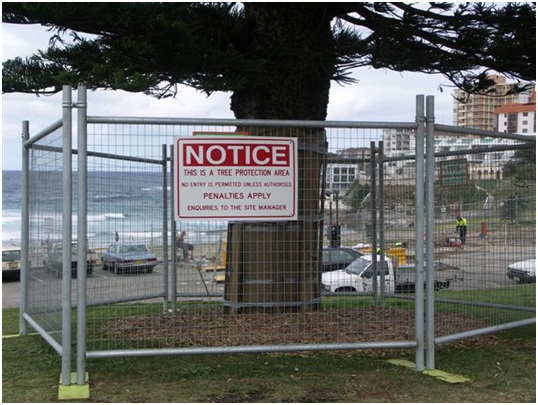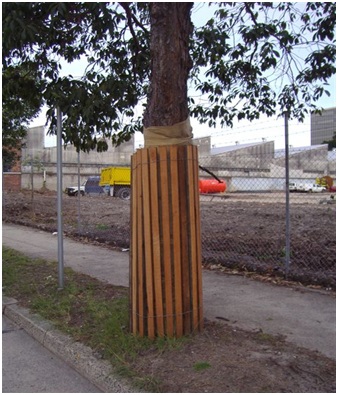Trees and development
| The information below is general in nature. For a more thorough explainer of Development Applications, visit the Planning & Development section. | |
When planning a development, any trees or vegetation located on site or on adjoining land must be shown in detail on the development application and consider the following Council objectives:
- Developments should be designed to minimise or avoid potential conflict between trees and structures
- Existing prominent trees should be retained and incorporated as part of the design
- Development must not result in the loss of tree canopy
- Existing and future tree growth both above and below ground must be a consideration when building close to a tree
- Trees identified to be retained are to be protected in accordance with Australian Standard AS 4970 – Protection of Trees on Development Sites
- Arboricultural Impact Assessments are required for trees with moderate or high retention values that may be impacted by a proposed development.
To maintain Waverley’s urban canopy cover, where trees are approved for removal, sufficient landscape area and deep soil planting areas must remain to allow for replanting of replacement trees.
A Landscape Plan must be submitted showing the locations of tree species, other proposed plants species, any existing trees and vegetation to be maintained and the area of the canopy on the Landscape Plan when plantings are mature.
All approved tree work must be carried out by minimum AQF Level 3 arborist in accordance with AS 4373-2007 Pruning of amenity trees.
All trees located on site must be shown on the site plan submitted with the development application. This includes trees on adjacent properties and any street or public trees within four metres of the site boundary.
The site plan must include:
- The exact location of all trees with each tree numbered
- For each tree ID, the common/ scientific name, height, canopy spread, trunk diameter at 1.4 metres above ground level and number of trunks if more than one
- The total canopy spread in area
- Which trees will be retained, removed, pruned or transplanted
- If any trees on neighbouring properties require pruning, then permission must be gained from the owner of the tree(s) and an application to Prune, or Remove Trees on Private Property is then to be presented to Council for processing
- If any trees on Council owned land require pruning, the applicant is to supply a tree pruning report from an Arborist with AQF level 5 qualification or above with photos showing the branches that need to be removed
- If approval is granted the applicant may prune the tree at their expense, by an experienced Arborist/Horticulturist (with a minimum of the Horticulture Certificate or Tree Surgery Certificate)
Before plans have been developed it is advisable to have a qualified arborist do a pre-DA assessment of trees located on site and any adjacent trees that may be impacted by the development. The assessment must be in accordance with the Australian Standard AS 4970 – Protection of Trees on Development Sites.
The assessment will:
- Identify trees with a moderate or high retention value
- Inform and advise of any potential hazards
- Minimise impacts on trees by suggesting appropriate construction methods or design if necessary
- Help ensure the retention and protection of trees
- Minimise delays in the development assessment process The report is to accompany the development application
When a proposed development is deemed by Council to have an impact on trees with a moderate to high retention value, the applicant will be required to submit an Arboricultural Impact Assessment report. The report must be prepared by a qualified arborist who has a Diploma of Horticulture (Australian Qualifications Framework Level 5). Please note there is a difference in skill level between an arborist that prunes trees and a consultant arborist.
The report is to include as a minimum:
- Details and estimates of Tree Protection Zones and Minimum Setback Distances for each numbered tree based on the Australian Standard AS 4970 – Protection of Trees on Development Sites
- A separate tree plan clearly showing all trees to be retained/removed/transplanted and each tree numbered
- Tree assessment and retention value based on an industry accepted standard
- A comprehensive discussion/assessment of the impact of construction works including
- (i) Details of any soil modification i.e. cut and fill, excavations
- (ii) Details of any tree pruning for building clearance or tree health
- (iii) Site works including hoardings; temporary site structures; wash-down areas and vehicle access
- (iv) Impact of the proposed building structure and location of services
- (v) Impact from landscape modifications on site trees
- (vi) Details of any replacement planting
- Root mapping report where required
- Tree protection specifications and signage
- An outline of WHS and tree protection procedures to be followed on site and appropriate induction for all on-site staff and sub-contractors
- A post construction tree maintenance/monitoring program which can be used as conditions should the application be approved
All reports must:
- Be in accordance with the Australian Standard 4970 – Protection of Trees on Development Sites
- Include recommendations for minimising loss of landscape amenity.
- Be thorough, balanced and objective in assessing the impact on the tree’s current and future health and condition.

Tree protection on Bondi Beach
The assessment for removal or pruning of trees forms part of the development application process.
In evaluating an application to alter or remove a tree on private land, the assessment will consider:
- the environmental, cultural and amenity value of the tree
- the effect on the health of the tree from branch and/or root pruning
- whether the tree shows poor form and shape/vigour typical of the species
- its location within the construction zone of the proposed building and whether design modifications can be made to minimise damage to the tree’s root zone and canopy
- whether the tree is located in a habitat corridor and provides habitat or fauna canopy connectivity
- the evaluation and recommendations of any arborist reports
- the occurrence (or lack of) other vegetation nearby and whether appropriate replacement species can be planted.
Trees adjacent or within four (4) metres of the site and identified as medium to high retention value and potentially impacted by the development process require protection measures in accordance with the Australian Standard AS 4970 - Protection of Trees on Development Sites during the demolition and construction phases of development.
An Arboricultural Impact Assessment is required to provide recommendations for tree protection. See appendices for report requirements.

Conditions and/or bonds will be applied where necessary to ensure maintenance procedures are followed for the protection of trees on adjacent public land or for the successful establishment of new trees. Compliance reporting is required for the duration of the bond. This bond may be wholly or partially forfeited if the tree is structurally damaged or removed during demolition or construction.
Applications to erect construction hoardings on public land must show the locations of any tree within four (4) metres of the proposed hoarding footprint. A bond for the protection of trees affected by a proposed hoarding will be imposed and may be forfeited if the tree is damaged or removed during demolition or construction.
For trees listed as heritage, on the Significant Tree Register or considered prominent in an urban conservation area, an Arboricultural Impact Assessment must be submitted with the development application.
In the case of heritage trees or those listed on the Significant Tree Register, the architectural proposal should aim to integrate the tree with the built form and promote its environmental values.
Minor and small-scale development often does not require development assessment by Council. This type of development is identified as ‘exempt development’ or ‘complying development’.
However, if trees, located on site or adjoining land and protected by Part B3 – Tree Preservation of the Waverley DCP, will be affected by construction or demolition works a separate development application permit application may be required.
To maintain and potentially increase urban tree canopy cover, replacement planting is a condition of approval for development applications.
Replacement trees must be an advanced approved species and be planted and maintained to maturity. Where there is insufficient space for replanting an advanced tree, the applicant is to provide offset planting on public land.
Generally, for every tree removed, the replacement of a minimum of three (3) off-site trees will be required. This will be undertaken by entering into a deed of agreement with Council.
Audit checks of replacement planting will be carried out by Council.
Quick links
Related forms/documents

